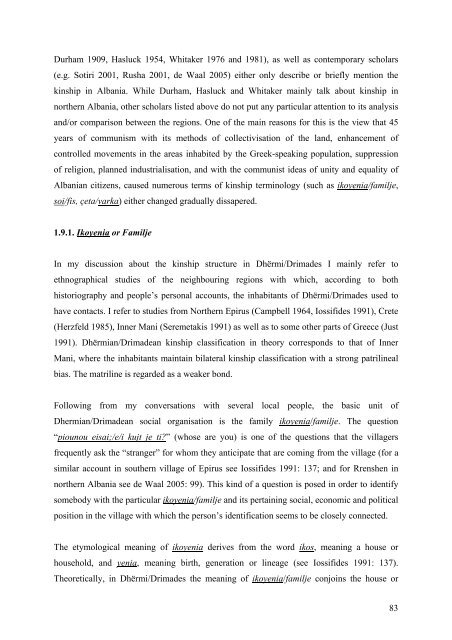university of nova gorica graduate school contested spaces and ...
university of nova gorica graduate school contested spaces and ...
university of nova gorica graduate school contested spaces and ...
You also want an ePaper? Increase the reach of your titles
YUMPU automatically turns print PDFs into web optimized ePapers that Google loves.
Durham 1909, Hasluck 1954, Whitaker 1976 <strong>and</strong> 1981), as well as contemporary scholars<br />
(e.g. Sotiri 2001, Rusha 2001, de Waal 2005) either only describe or briefly mention the<br />
kinship in Albania. While Durham, Hasluck <strong>and</strong> Whitaker mainly talk about kinship in<br />
northern Albania, other scholars listed above do not put any particular attention to its analysis<br />
<strong>and</strong>/or comparison between the regions. One <strong>of</strong> the main reasons for this is the view that 45<br />
years <strong>of</strong> communism with its methods <strong>of</strong> collectivisation <strong>of</strong> the l<strong>and</strong>, enhancement <strong>of</strong><br />
controlled movements in the areas inhabited by the Greek-speaking population, suppression<br />
<strong>of</strong> religion, planned industrialisation, <strong>and</strong> with the communist ideas <strong>of</strong> unity <strong>and</strong> equality <strong>of</strong><br />
Albanian citizens, caused numerous terms <strong>of</strong> kinship terminology (such as ikoyenia/familje,<br />
soi/fis, çeta/varka) either changed gradually dissapered.<br />
1.9.1. Ikoyenia or Familje<br />
In my discussion about the kinship structure in Dhërmi/Drimades I mainly refer to<br />
ethnographical studies <strong>of</strong> the neighbouring regions with which, according to both<br />
historiography <strong>and</strong> people’s personal accounts, the inhabitants <strong>of</strong> Dhërmi/Drimades used to<br />
have contacts. I refer to studies from Northern Epirus (Campbell 1964, Iossifides 1991), Crete<br />
(Herzfeld 1985), Inner Mani (Seremetakis 1991) as well as to some other parts <strong>of</strong> Greece (Just<br />
1991). Dhërmian/Drimadean kinship classification in theory corresponds to that <strong>of</strong> Inner<br />
Mani, where the inhabitants maintain bilateral kinship classification with a strong patrilineal<br />
bias. The matriline is regarded as a weaker bond.<br />
Following from my conversations with several local people, the basic unit <strong>of</strong><br />
Dhermian/Drimadean social organisation is the family ikoyenia/familje. The question<br />
“piounou eisai;/e/i kujt je ti?” (whose are you) is one <strong>of</strong> the questions that the villagers<br />
frequently ask the “stranger” for whom they anticipate that are coming from the village (for a<br />
similar account in southern village <strong>of</strong> Epirus see Iossifides 1991: 137; <strong>and</strong> for Rrenshen in<br />
northern Albania see de Waal 2005: 99). This kind <strong>of</strong> a question is posed in order to identify<br />
somebody with the particular ikoyenia/familje <strong>and</strong> its pertaining social, economic <strong>and</strong> political<br />
position in the village with which the person’s identification seems to be closely connected.<br />
The etymological meaning <strong>of</strong> ikoyenia derives from the word ikos, meaning a house or<br />
household, <strong>and</strong> yenia, meaning birth, generation or lineage (see Iossifides 1991: 137).<br />
Theoretically, in Dhërmi/Drimades the meaning <strong>of</strong> ikoyenia/familje conjoins the house or<br />
83

















